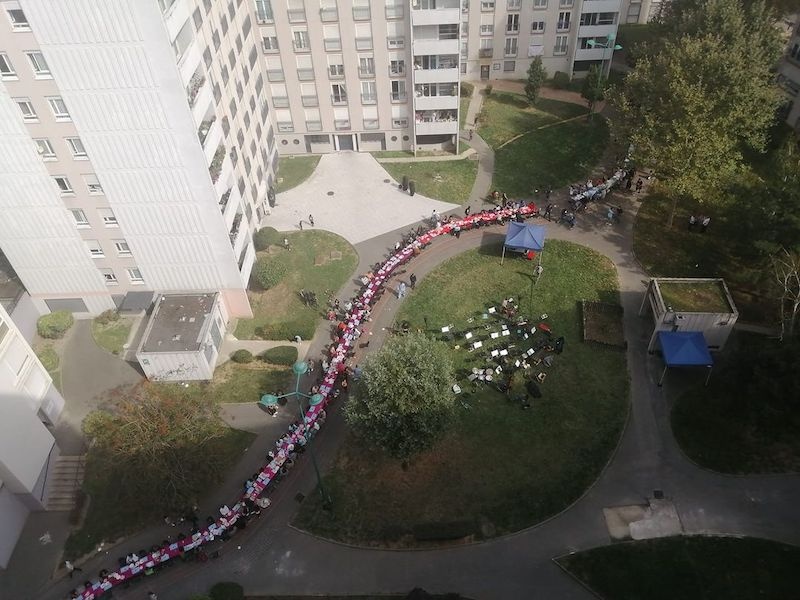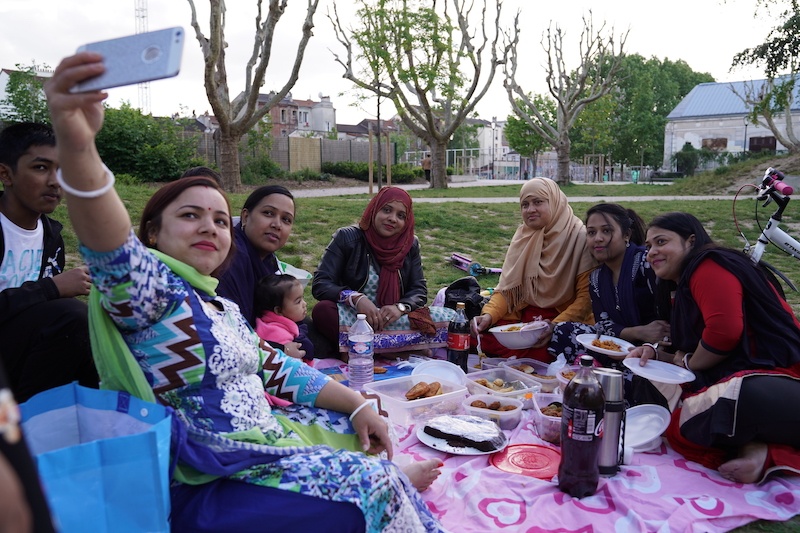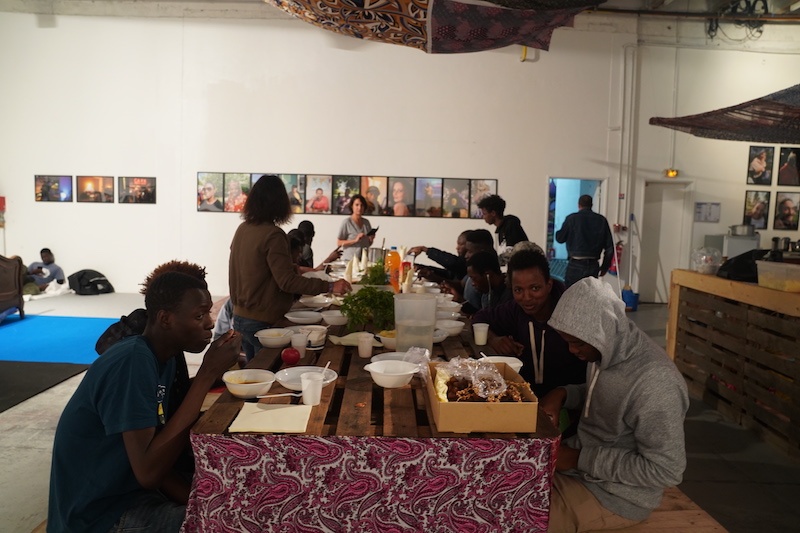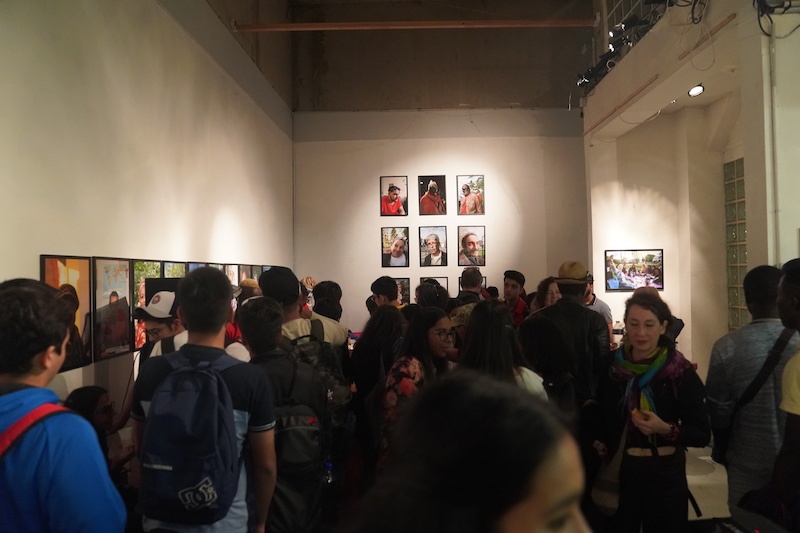Can you start off by telling me what it is you do?
I do different things but I think I try to connect people through art, through installations, through theatre, through performances. My art is strictly based on happiness. I want to connect with people, create beauty, share feelings, imagine how the world could be and how we can live together. It’s a kind of research connected to humans, to who we are and who we want to be, and how it is possible to change our environment, which often seems close to impossible. I try to do little poetic and simple things to spread happiness. I do this in multicultural places with a lot of social diversity.
You just said your art is strictly based on happiness. Can you explain that a bit more?
When I create something I want it to be fun and accessible. It needs to be something that doesn’t need my direction, something that can be done without having knowledge about art. It’s also always a research process. I try to open the world of the contemporary art. I want to investigate how we can achieve more togetherness, how the participants can feel happier by being part of an art project, and how they will feel a part of it and not just feel like spectators.
Test La plus grande table du monde cité Soubise - Saint-Ouen - Septembre 2021 - Compagnie Perdus dans la baignoire
What project are you currently working on?
It’s called La Plus Grande Table Du Monde (The Biggest Table in the World) and it’s an invitation to all inhabitants of Saint-Denis, Saint-Ouen (Greater Paris neighborhoods) and elsewhere to come and celebrate conviviality in Seine-Saint-Denis. The objective for the final table is to link the town hall of Saint-Ouen to the basilica of Saint-Denis with tables, so that 10 000 people can come and share a meal. There will be food but people are also encouraged to bring their own and artists of different disciplines will entertain at the table. I’ve done several of these tables before and the largest and final table will happen in September. It’s a project to bring together inhabitants of different neighborhoods, show solidarity to the whole world, it’s a counterpoint to the times we live in, a desire to give meaning to our lives and to connect.
So you work with a lot of neighborhood and community organizations and with locals. How do you involve everyone so that they feel part of it and not instrumentalized?
I spend a lot of time meeting people again and again. I literally open the work process up. I tell them they can add their own things into the project. I’m not the one deciding what will go into the project or not. We do it as a collective. But of course it takes a lot of time for this kind of work process to be established. I try to be as accessible as possible. Sometimes it’s really hard. The every day life of a lot of people I work with is really harsh and so when I come as a white man who experiences happiness in these kind of neighborhoods, it can be quite violent for them. I have to be careful with the words I choose because sometimes it’s difficult for them to understand what I want to do. They might think I have a political agenda, that I want to modify the suburbs and harm the people living there because this happens a lot. So I have to destroy all of these fears and ideas before I start working with people. So far I’ve always succeeded with my projects. Sometimes it’s easy, sometimes it’s really hard with fights between different neighborhood organizations.
You work with so many people. How do you make sure not to burn out?
I feel really close to a burn out every time I do a project. In May I organized four Largest Table of the World events. I worked around 90 hours a week. I felt close to a burn out and spent five days in the mountains to detox. My work’s hard, there’s a lot of coordination and management of people I don’t know well. But the more of these projects I do, the more I learn about taking care of myself. But it’s a hard balance to keep because I want to feel alive, I want to have a real impact on the lives of others so I give 100%. I think I always manage to avoid having a burnout because of the happiness others feel through the projects, seeing their smiles, seeing how happy they are at accomplishing something together. There are always a handful of people who are so involved in the project, they make the project theirs, it becomes our project and not my project. And all the friendships that are created give me energy.
I can imagine how creating something other people can breathe life into would be very energizing.
Yeah, some neighborhood associations have already said they want to continue the table project next year even if I’m not involved.
Your way of working makes me think of urban acupuncture.
Urban acupuncture? I haven’t heard of it.
An architect called Manuel de Sola Morales came up with the term. It’s a theory that combines contemporary urban design with traditional Chinese acupuncture. The idea is that you use small interventions to release stress in urban environments the way you use needles in acupuncture to get energy flowing again.
Your way of working is quite unconventional and often times places that can provide money have trouble understanding more unconventional approaches. Do you have a day job to do all this?
I get financial support to do all of this. I earn money putting on these projects, but I also work as an actor. I act around four months a year. I work in theatre and TV. Half my money I earn with acting and the other half by putting on events strictly based on meeting each other and being happy.
Salade de racines – Installation hospitalière - 2019
Salade de racines – Installation hospitalière - 2019
You get support from the city of Paris?
Yeah because the projects are done in very poor areas so the government gives some money to create things with and for the people. Because my project is very social I also get support for being an intergenerational project. A few years ago it was hard, I was making these projects with 3000 Euro. Now I get around 200,000 Euro so it’s kind of big money. I wasn’t seen as an artist when I first started doing these projects. It’s becoming easier and easier now.
What is the most valuable aspect of your work to you personally?
The people. I build real friendships with some of the people I come across through my work. The links being created through people is so important, a human network that is strong and peaceful and happy is really beautiful to me. I’ve been doing the table project for two years and we have worked with over 150 organizations. People meet each other and will continue doing things together. The project is creating real human links and that’s so valuable to me.
How did you end up doing this kind of work?
My mother sold train tickets so from a young age I was able to travel for free or for really cheap. When I was 15 I started taking trains to other countries to visit friends. I traveled so much and met so many people. My mother and father cooked a lot at home so I knew how to cook. When I stayed with people I’d say I don’t know how to do anything but I can cook for you. It made people happy and it made me happy. So I decided to follow this method. I hitchhiked all over the world, to more than 60 countries and always slept in the homes of random people, traveled with very little money, didn’t plan anything. I would hold up a sign on the side of the road reading: “Your way is my way.” Then I started reading and thinking about what all these encounters were doing to me as a human. I just tried to open my mind and listened to all the possibilities offered by life. I did this from the age of 15 to 25 during my free time. After my studies I took a year just to do this.
Did you study acting?
I studied acting the second time I studied. First, I studied economic management. It made me really sad. I was really lost about what to do. First I actually tried to study electronic systems but I was so bad. I quit after three months. I felt so lost and thought my parents would be happy if I got a diploma and afterwards I can do what I want. I studied this but was so sad and almost got into fights with my professors. The world being described to us during these studies was a world I didn’t want to live in. I did get my diploma. My final project was creating a humanitarian organization with three students who were lost like me. Then I traveled for a year and came back. I met actors, photographers and architects on my travels. It was a totally new discovery for me because my parents are just common people. Seeing that it was possible to work within art made me really happy and I thought that’s what I want to do.
Yvan Loiseau Recommends:
Manga: Buddha by Osuma Tezuka
Music: La Chica El Agua
Book: Marelle - Julio Cortázar
Artist: ecilop_nationale
Photographer: Romain Laurendeau
This content originally appeared on The Creative Independent and was authored by Grashina Gabelmann.
Grashina Gabelmann | Radio Free (2022-09-22T07:00:00+00:00) Artist and actor Yvan Loiseau on creating art as a community. Retrieved from https://www.radiofree.org/2022/09/22/artist-and-actor-yvan-loiseau-on-creating-art-as-a-community/
Please log in to upload a file.
There are no updates yet.
Click the Upload button above to add an update.




